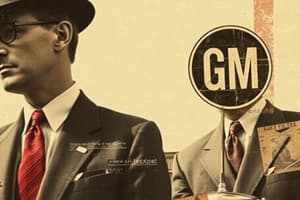Podcast
Questions and Answers
In the context of decision-making, how does bounded rationality MOST significantly challenge the idealized rational model, particularly for directors?
In the context of decision-making, how does bounded rationality MOST significantly challenge the idealized rational model, particularly for directors?
- It asserts that directors can overcome personal biases by adhering strictly to statistical models, thereby achieving objectivity in decision outcomes.
- It recognizes that directors operate with incomplete information and limited cognitive capacities, impacting their ability to make perfectly rational decisions. (correct)
- It implies that directors must dedicate extensive resources to gather exhaustive information, irrespective of time constraints, to ensure optimal choices.
- It suggests that directors should prioritize gut feelings over data analysis, as intuition inherently leads to better strategic choices.
Considering the Mayer-Salovey Four-Branch Model of emotional intelligence, which branch is MOST directly compromised in individuals exhibiting traits associated with the 'dark triad'?
Considering the Mayer-Salovey Four-Branch Model of emotional intelligence, which branch is MOST directly compromised in individuals exhibiting traits associated with the 'dark triad'?
- Emotional facilitation of thought, since psychopathic tendencies directly inhibit cognitive flexibility required for emotional appraisal.
- Emotional management, given the exploitative behavior and disregard for others' feelings characteristic of Machiavellianism. (correct)
- Emotional understanding, due to inherent impairments in recognizing the subtle interplay of emotional blends and contradictory states.
- Emotional perception and expression, as narcissistic individuals commonly exaggerate their emotional displays for manipulative purposes.
With the aim of bolstering psychological safety, what action would be MOST imperative for a board to adopt following a period characterized by repeated project failures and suppressed dissenting opinions?
With the aim of bolstering psychological safety, what action would be MOST imperative for a board to adopt following a period characterized by repeated project failures and suppressed dissenting opinions?
- Implementing rigorous after-action reviews while assuring that any missteps are directly linked to tangible and measurable performance infractions.
- Affirming explicit protections that encourage honesty and candor while assuring that there will be no recrimination for respectfully voiced contrary viewpoints. (correct)
- Instituting a series of team-building activities purposefully designed to foster group cohesion while strategically downplaying any previous disagreements.
- Restructuring the board’s communication conventions to ensure information is thoroughly vetted, minimizing reliance on subjective and unverifiable data.
Regarding the interplay between leaders and followers, what behavioral norms would be MOST integral for directors to cultivate throughout an organization to promote a culture of robust, ethical decision-making regarding ethical corporate governance?
Regarding the interplay between leaders and followers, what behavioral norms would be MOST integral for directors to cultivate throughout an organization to promote a culture of robust, ethical decision-making regarding ethical corporate governance?
Considering the application of social identity theory and self-categorization theory in leadership contexts, what action would a director of a newly merged organization prioritize to foster a cohesive team identity amongst originally disparate factions?
Considering the application of social identity theory and self-categorization theory in leadership contexts, what action would a director of a newly merged organization prioritize to foster a cohesive team identity amongst originally disparate factions?
During periods of organizational change, which approach enables team cohesion and effective leadership-followership at an optimum level?
During periods of organizational change, which approach enables team cohesion and effective leadership-followership at an optimum level?
Contrasting conventional command-and-control with contemporary social-engagement leadership approaches, which action MOST effectively cultivates an ethical and innovative organizational culture?
Contrasting conventional command-and-control with contemporary social-engagement leadership approaches, which action MOST effectively cultivates an ethical and innovative organizational culture?
What attribute is MOST indispensable for boards to adopt an agile strategic navigation to manage continuous volatility and ambiguity?
What attribute is MOST indispensable for boards to adopt an agile strategic navigation to manage continuous volatility and ambiguity?
Which assessment criteria is MOST essential when evaluating a board's effectiveness considering their ability to adapt an organization under volatile conditions?
Which assessment criteria is MOST essential when evaluating a board's effectiveness considering their ability to adapt an organization under volatile conditions?
Which action would be MOST strategic for a board seeking to cultivate a climate encouraging ethical conduct given a significant risk of non-compliance?
Which action would be MOST strategic for a board seeking to cultivate a climate encouraging ethical conduct given a significant risk of non-compliance?
In addressing team dysfunction, which approach would have the MOST foundational implication by the chart or task owner?
In addressing team dysfunction, which approach would have the MOST foundational implication by the chart or task owner?
Flashcards
What is Leadership?
What is Leadership?
Involves an individual influencing others to move towards a common goal. Leaders need followers.
Leadership vs Management
Leadership vs Management
Managers focus on stability; leaders on innovation. Managers ensure efficiency; leaders inspire agreement on what to do.
Inspiration in Leadership
Inspiration in Leadership
Leaders inspire action through vision and energy. Charisma, though powerful, has a dark side if values misalign.
Board Primary Function
Board Primary Function
Signup and view all the flashcards
Organisational Vision
Organisational Vision
Signup and view all the flashcards
Organisational Purpose
Organisational Purpose
Signup and view all the flashcards
Strategy and Motive Force
Strategy and Motive Force
Signup and view all the flashcards
Organisational Values
Organisational Values
Signup and view all the flashcards
Effective Leadership
Effective Leadership
Signup and view all the flashcards
Leaders at All Levels
Leaders at All Levels
Signup and view all the flashcards
Adapting Leadership Style
Adapting Leadership Style
Signup and view all the flashcards
What is effective, fast leadership?
What is effective, fast leadership?
Signup and view all the flashcards
Leaders and Followers
Leaders and Followers
Signup and view all the flashcards
What is great leadership skills?
What is great leadership skills?
Signup and view all the flashcards
How is a board run well?
How is a board run well?
Signup and view all the flashcards
The Key to leaders to take on a new team.
The Key to leaders to take on a new team.
Signup and view all the flashcards
What do followers want?
What do followers want?
Signup and view all the flashcards
For the modern workplace.
For the modern workplace.
Signup and view all the flashcards
Followers want groups
Followers want groups
Signup and view all the flashcards
The best part of what a leader must do
The best part of what a leader must do
Signup and view all the flashcards
The 3Es to success.
The 3Es to success.
Signup and view all the flashcards
What does an Authentic Leader represent?
What does an Authentic Leader represent?
Signup and view all the flashcards
Each members actions as part of a team
Each members actions as part of a team
Signup and view all the flashcards
Good table leaders will:
Good table leaders will:
Signup and view all the flashcards
Poor Group Dynamic leads to. . .
Poor Group Dynamic leads to. . .
Signup and view all the flashcards
The key to success on group dynamic.
The key to success on group dynamic.
Signup and view all the flashcards
Study Notes
Leadership for Directors - Module Overview
- The module explores leadership concepts, models, and practical steps for self-development and colleague support.
- Contrasts leadership with management, highlighting followership's importance.
- Aims to enhance leadership skills organization wide.
Defining Leadership
- Leadership generally involves one or more individuals influencing others towards a common goal
- Leaders require followers, but titles do not guarantee authority
- Tim Hannagan: Leadership motivates others towards specific goals
- Gary Yukl: Leadership is influencing and facilitating shared objectives.
Leadership vs Management
- Yukl: Managers focus on stability, leaders on innovation
- Managers improve efficiency, leaders build agreements on action.
- Leaders decide the direction, managers ensure execution
- Charismatic leadership involves inspiring followers through personal vision and energy.
- Transformational leaders inspire through vision and valuing individual contributions
Practices of Exemplary Leaders
- Challenge the process by seeking opportunities and taking risks
- Inspire shared vision, communicating an inspiring future
- Strengthen others and foster collaboration
- Model the way, set an example through behavior and wins
- Recognize contributions and celebrate team successes.
Improving Leadership Capability
- Be aware of self and create continuous feedback culture with respect and honesty
- Build trust across boards by raising awareness of each other's backgrounds and hopes
- Foster a destress-free environment for learning to lead at all levels and enable positive emotion
The Learning Board Model
- The learning board model examines board performance balancing conformance and performance.
- Conformance includes accountability and operational review
- Performance includes strategy and forming policies
- Boards often prioritize conformance over vision and strategy.
Vision, Purpose, and Values
- Vision and purpose define the strategic direction for the delivery strategy for organisations
- Vision answers "what" and "where" the organisation seeks to be.
- Purpose explains "why" the organisation does what it does, as well as defining external ethos
- A five-year strategy could be deployed in year 3 of longer term plan, however is subject to external requirements
- Values guide "how" tasks should be accomplished and are useful for accountability.
Values-Driven Culture
- Starts with a strong and inspiring vision from the boardroom
- Focus on a short list of values, gathering feedback from all employee leels
- Ensure shared understanding and clear alignment of meaning of those values
- Communication of that vision and creative distribution within the company
- Commitment from leaders and managers to set feedback based on those values, as well
Examples of Leadership
- Zhang Ruimin of Haier Group, innovated business, eventually shifting to a platform company providing technology
- In 2022 Zhang retired handing over leaderful organisation where staff adapt to market changes
- Emma Warmsley, as CEO of GlaxoSmithKline, reorganized the company, reversed exit from existing markets given previous issues
- Mary Barra, CEO of General Motors, had a clear focus on product
- Yvon, Chouinard, Founder of Patagonia put value in environment protection and reversal of climate change
The IoD Director Competency Framework
- Framework supports the director's role to succeed.
- Knowledge- director's application of theoretical information
- Skills - expertise which directors bring
- Mindset - attitude and behaviour
Studying That Suits You
Use AI to generate personalized quizzes and flashcards to suit your learning preferences.




